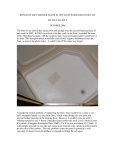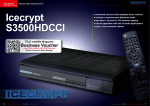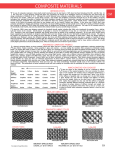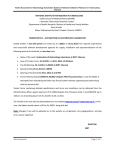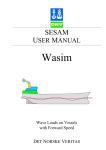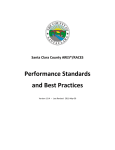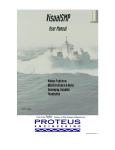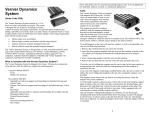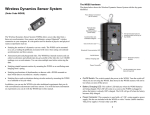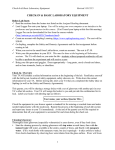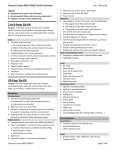Download ASSEMBLY OF THE ROVER X2 (12B)
Transcript
ASSEMBLY OF THE ROVER X2 (12B) Cut List Review the drawings provided for geometry and measurements of components that will need to be cut. o 3 Foam Hull Segments o 2 Plywood Decks o 2 Skegs o 2 Outer Fins o 1 Center Fin o 1 Port Rudder (note: the port and starboard rudders are mirrors of each other) o 1 Starboard Rudder o Bow bumper The foam hull can be cut from one 4'x8'x2” piece of foam insulation paneling, cut into four 2'x4' sections. Save any scrap pieces, they may be useful for patching later, or for use a base for your ROVER. Plywood skegs, fins and rudders are all cut from 5/16” birch from AircraftSpruce.com. This is dense, high-quality wood made for R/C applications is comparatively expensive than that which could be sourced from a home improvement store, but it does not absorb water as easily. The plywood decks were cut from 1/8” birch plywood, also from AircraftSpruce.com. The bow bumper we used is two 1”x1” balsa blocks cut to fit the contour of boat. This is not essential, but will protect the foam insulation from impacts during handling and operations. All components were cut with a band saw and finished with a bench-top sander, but this could also be accomplished with a jig saw or even hand tools. xxx_how to route skeg slots_xxx Tips for Epoxy Application • Be sure to use epoxy in well ventilated areas • Use gloves and eye protection • Keep clear of coated surfaces, epoxy can easily stick to your clothes and body • Especially when working with short cure time epoxies, be ready to apply before you start mixing, there is a limited time that the mixture will remain thin enough to spread, this is known as “pot time” • Each batch of epoxy will require a new container, mixing stick and brushes • Mix the epoxy according to the instructions for your brand • When mixing, work quickly enough to maximize pot time, but attempt to minimize bubbles that will visible in top coats. • Epoxy may be hot after mixing, handle with caution • A putty knife or similar flat scraper/spreader can be used to spread epoxy over a large surface and if cleaned, can be used for multiple coats • Use a chip brush or inexpensive paint brush to ensure all surface, corners and edges are completely. As stated earlier, new brushes will be needed for each application. • Most epoxies are thin and meant to applied in layers, attempting a thick coat will result in wasted epoxy, runs and extra clean up. • Use quick cure (5, 6, or 30 minutes) epoxies for filling gaps, patching holes and attaching parts that may slip if not held in place until set. • Cover your work area with a heavy duty plastic drop cloth to protect you area and prevent epoxy coated surfaces from sticking. Hull Assembly In this section you will be assembling the structure of your ROVER. Do not rush the epoxy process; a sloppy job here will affect the rest of the project and the lifetime of your boat. Step 1 – Hull 1 • Using standard set epoxy (8-24 hours); join the lower plywood deck to the top of bottom foam section. If slots have been cut for fins, ensure proper alignment and test fit all three before allowing epoxy to set • When mating different materials (wood & foam) to use enough epoxy to allow the two parts stick properly • Apply clamps or weights to top to maintain contact between layers while curing • Allow to fully cure Step 2 – Hull 2 • In the same manner as above, epoxy the middle foam section to the lower plywood deck (completed hull assembly), check for fit of fins, clamp, and allow to cure Step 3 – Hull 3 • Epoxy top foam section to middle foam section (no plywood in between) Step 4 – Top Deck • Epoxy the top plywood deck to the top foam section Step 5 – Bow Bumper • If using two balsa bow bumper segments as described in the plans, use a quick cure epoxy to join the blocks together and allow to fully cure • Using a quick cure epoxy mount the bow bumper to the bow, flush with the top deck. This is more easily accomplished by inverting the entire hull assembly and placing it on a flat surface covered with a smooth plastic drop cloth Step 6 – Center Fin • Before mounting fins, review drawings and pictures provided. There are a number of small holes along the forward edge that will later be used to secure the power wiring for the thrusters, it is recommended to drill these holes now and remove any epoxy that gets caught in them later • Using a quick cure epoxy, insert the center fin into the center slot at the stern • The bottom of the fin should be flush with the bottom of the hull Step 7 – Fins and Skegs • For fin and skeg mounting, the entire hull should be placed upside-down on a table with the center fin and slots hanging over the edge • Using a quick cure epoxy, mount the port and starboard skegs into the slots running down the bottom of the hull • With the skegs in place, using the same epoxy, mount the port and starboard fins into the slots at the stern. The fins should protrude below the hull two inches and be flush with the skegs. Use epoxy to glue the fins to the skegs and to fill any gaps or cracks between the skegs/fins and the hull. A thinner, long-set epoxy will run down cracks and drip • Hold the fins in place until the epoxy has set enough that they do not slip out of place, then allow to cure NOTE: Now that the hull has been assembled, a mount or stand should be constructed to rest the boat on the flat portion of the keel rather than on the skegs and bow. Scrap foam is useful for this purpose Step 8 – Sanding • Using a rasp or file, shape the bow and edges of the hull as desired. To remove large amounts of material, a sharp knife or hacksaw can be used with caution. The boat will float and operate as is, but refining its shape will reduce drag and adds ascetic quality o Sand the entire surface of the boat, fins, skegs and rudders to smooth the wood and ensure all the layers are even and flush. Pay particular attention to sharp corners on wood components such as the fins and rudders • Sanding can be performed manually or with power tools using varying grits of sandpaper. A lower grit sandpaper will remove more material with each pass, but leaves the surface rough and can gouge the foam • To avoid issues later, test fit thrusters after sanding to ensure proper fit. Epoxy applied in the next step will only make a tight fit more difficult to fix • After sanding, remove dust and loose material with damp cloth and dry Step 9 – Epoxy Shell • Using a quick cure epoxy, fill any cracks, holes, seams or gouges on the boats surface. Quick cure can also be used to fillet any sharp joints for a more professional look • Coat the entire hull, fins, skegs and rudders with epoxy for protection from water and handling. As discussed in the tips section, use 3-4 thin coats to gradually build up the material rather than trying to load one thick coat Step 10 – Paint (Optional) • If you decide to paint or decorate you ROVER, after a light sanding with a fine (high grit) sandpaper, use an exterior latex paint with at least two coats Step 11 – Rudders • Using 3 small hinges each, attach the port and starboard rudders to the corresponding fins • Assuming they were cut as described in the drawings, identify and orient the fins as follows: o The forward edge of each rudder should be beveled to allow for knuckle of the hinge to fit unobstructed. Each bevel should face toward the inside of the boat so that when the hinges are mounted from the outside, the pin and bevel are not visible from the side. o The top edge is perpendicular to the forward edge, while the lower should rise toward the back • When mounted the top edges of the fin and rudder should be even, resulting in the lower edge of the rudder being slightly shorter than the bottom, this is intentional, it prevents the rudder from hanging on submerged vegetation or hazards Step 12 – Payload Compartments • To allow for flexibility and access when installing electrical components, we recommend fitting the pay load compartments and mounting the hardware to the hull, but not fully installing the coolers until finished • Place the payload containers (Coleman coolers) in the cutout in the center of boat. The exact orientation of the lids and handles is a matter of preference, but for the implementation documented here, we used the following: o The rear most cooler opens toward the bow, preventing the thruster wiring from interfering with battery removal o The handle of the center cooler is removed so that instrument wiring can be routed into it without adding more holes o • The lids of both the center and forward coolers open toward the bow. The brackets we used were fabricated from a piece of scrap angle aluminum cut to approximately 1” sections and a hole drilled in each face. Any screw or bolt long enough to penetrate the cooler should be sufficient to hold the coolers in place. L-shaped brackets could also be purchased from a hardware store Electrical and Control System Assembly and Installation Step 1 – Prepare Electronic Speed Controller • The ESCs we used came equipped with Dean's Ultra power inputs and an internal Battery Eliminator Circuit (BEC) neither of which will be used on ROVER • The power inputs will be replaced with a two-piece, color-coded PowerPole connector. o Remove the existing Dean's Ultra plug by cutting it off as close to the connection as possible to conserve the leads o Strip 1/4” of insulation from the ends of the leads and solder on the contacts o The red and black connectors slide on and lock in only one orientation, there is a tongue and groove connection that will keep the positive and negative poles aligned properly o • Be sure to follow any instructions provided with your particular components To disable the BEC: o Looking at the top side of the ESC’s receiver plug, using a tiny flat bladed screwdriver, carefully raise the plastic tab in the middle which holds the pin for the RED (+) wire. Gently pull the red wire out of the receiver plug. Be sure to cover the bare pin with heat shrink tubing or electrical tape so that it cannot short-circuit against other items • Using a silicon sealant, fill each open end of the ESCs to prevent water intrusion Step 2 – Assemble and Prepare Thrusters Assemble the Delta V ducted fans according to the instructions provided Because of the design of the blades, it is more efficient to reverse the orientation of the motor and housing assembly of the reverse thruster and place the cowling on the back The power lines supplied with the Delta V ducted fans must be extended to reach the connections with the ESCs The banana-type connectors attached to the power wires need to be removed by heating them with a soldering iron and twisting the wire away from the connection with pliers. The heat required to flow this solder is rather high, use caution when handling wire and connectors Cut off the ends of the wires to remove old solder, then remove about 1/4” of insulation Once all the connections have been removed from a thruster, test fit it in its final mounting location (port, center or starboard) to determine the length of the extension that will be needed. Twist the three wires around each other and route them as they would be in final assembly and measure out a long enough extension to connect the thruster to the ESC o Twisting wires keeps them neatly bundled and reduces EMI (electromagnetic interference) generated in the wires Cut the extension and strip each end approximately 1/4” Solder the banana plug previously removed from the power line to the extension and splice the 2 raw ends together Cover splice with heat shrink or electrical tape Step 3 – Prepare the battery Cut four black and four red sections of the 14awg silicon wire, approximately 6” to 8” in length Solder a power plug connector to one end of each wire according to the instructions in Step 1, and add the appropriate colored tip Gather the four red wires, splice them together and solder them to the positive pole of the battery. Repeat for black wires and negative pole. Cover joints with heat shrink or electrical tape Pair off all the connectors (red and black) and attach them together to result in four parallel 12v outputs Step 4 – Function Test Before mounting any components to the ROVER, it is advisable to perform a test of all components to ensure that they operate correctly understand how they will be connected later WARNING: Use extreme caution when testing thrusters. Carefully read safety guidelines before proceeding. Securely mount them to a sturdy surface or the fins. Do not stand behind them or in the plane of the propellers. Ensure all persons in the area are notified of testing and understand clearance areas. Review the ControlLayout.pdf and FutabaRecveiverPinOut.pdf diagrams of the R/C system as well as the images of the components Both rudder servos are connected to receiver PORT 1 by a Y-harness. Observe the color coding of the leads and make the connections to perverse this scheme The forward thrusters (port and starboard) are also connected to the receiver at PORT 3 using a Y-harness The reverse thruster (center) is connected directly to the receiver PORT 6 Finally, the BEC is attached through the ON/OFF switch to PORT 8. Check that the switch is in the OFF position See the Start-Up Procedures section of this document for instructions on connecting R/C system to power Following the safety guidelines provided, ensure that personnel are clear of thruster hazard areas before operating ROVER Testing components: o Using the right joystick, check the operation of both rudder servos. Looking at them head on with the writing down, both servos should turn clockwise when the control stick is moved left and counterclockwise when moved right. The connecting arms can be removed and repositioned to allow for the correct orientation when mounted to the ROVER o Slowly move thruster control stick (left joystick) forward until motors start. There is no need to extend beyond minimal power. Observe the direction of thrust. If fans are rotating in a direction other that desired, any two of the red, blue or black connections can be interchanged to reverse the direction. Return thruster power to OFF o Slowly move the reverse thruster control knob (above the right joystick) clockwise until motor starts. Observe the direction of thrust and correct if needed Follow the Shut-Down Procedures provided to safely turn off R/C system Step 5 – Mounting NOTE: Read through all instructions in this section and review figures before beginning, it is important understand how all the components will interact before making cuts or mounting hardware Cut cooler for rudder servos: o Place the base of a rudder servo against the side wall of the rear cooler, as far aft as possible that will allow the base of the servo to be inserted into the cooler without having to cut into the rear wall (see pictures) o Mark the outline of the base of the servo on the cooler with a fine tip marker or pencil and repeat for opposite side o Using a utility knife, cut the holes as small as possible (this is will be the most vulnerable area for water intrusion) o Insert both servos into the holes and use #4 washers and screws to secure them to the outside of the of the payload containers o Attach the arms to the servos pointed up by removing the screw at its base pulling it straight off, and replacing Mount the two forward thrusters on the port and starboard fins using the screw provided with them. The rear thruster is mounted on the center fin, with the spinner facing aft and the power lines forward. The cowling should still be able to fit on the forward rim. It is not an essential component but does reduce noise The three ESCs are secured to the top of the rear-most cooler with Velcro. Holes can be easily drilled through the lid of the cooler to route the power and control lines through. The outputs to the thrusters can be twisted and laid under the handle The BEC and ON/OFF switch can be mounted to the inside of the battery compartment with Velcro anywhere they will fit and allow the battery to be removed easily To connect rudders to servos: o Align rudder with fin in a neutral position, as if the boat were moving forward o Turn the arm of the servo to point straight up o Insert a screw-lock connector into the top hole of each servo arm. Loosen set-screw to allow easy movement of the pushrod o Attach the pushrod to the control horn by spreading the clevis and placing the pin into one of the holes of control horn. This may need to be to be adjusted later to improve alignment o Insert smooth end of pushrod into screw-lock connector and place the control horn against the rudder about 1” from the hinged edge and vertically level with top of the arm. The goal is to mount the horn to the rudder such that in neutral position the push rod is as straight as possible both longitudinally and horizontally and that the rudder has the maximum range of motion, wit out straining the rod. Depending on the particular control horns used, wood screws or bolts may be use to mount the horn to the rudder. If using bolts, mark the position of the mounting holes on the rudder, remove assembly and drill pilot holes, or wood screws can be inserted now o Do not tighten screw-locks on the servos arms yet. Servos have a neutral position that they should return to when the control stick is neutral, handling can easily move the servos, to align servo arms, connect the only the receiver to the battery and turn it on. The servos should center themselves. Now tighten set screws Step 6 – Initialization Now that all of the components are mounted, there are two settings that need to be adjusted (this step assumes you are using the Futaba 7c and Great Planes ESCs listed) o The ESC has a “break” feature that stops the motor abruptly when throttle is cut off. This is undesirable because it places undo stress on the motor when it stops and it can shorten the life of the motor To disable, follow the instructions provided in the user’s manual under the ESC Setup section o The swing of the rudders can be increased up to 40% by changing the settings of the Futaba controller Instrumentation We have elected to use Vernier sensors and the Vernier LabQuest 2 data logger. Vernier products provide relatively accurate measurements at a reasonable price and the LabQuest 2 has an internal battery, GPS receiver and is small enough for the payload containers of the ROVER. The LabQuest 2 Deluxe Water Quality Package includes large selection sensors that could be used on ROVER at a lower price than the individual pieces The handle of either the forward or center cargo container can be removed and the hole used to route the cables of the sensors Sensor mounting platforms can be made in any configuration desired as long as two considerations are made: o Sensor tips must sit below waterline o Mounts should be secured to ROVER with Velcro. This allows for removal when transporting and breakaway if caught on an obstruction YOUR ROVER IS NOW READY SCIENCE!!! See the ROVER Operations Manual for detailed instructions on conducting scientific missions with your new boat. Start-Up Procedures 1. Place battery in aft compartment 2. Set transmitter controls to starting positions (see diagram): Forward throttle (left joystick) to OFF, fully down Reverse throttle (knob) to OFF, fully counter-clockwise Rudders (right joystick) to neutral, centered NOTE: Starting system with controls in a position other than specified can change internal setting of the controller, receiver or ESCs 3. Turn on transmitter and have a team member hold it to ensure the boat is always under control 4. Connect the power leads of the BEC to the battery and turn the switch to ON. Announce to anyone present that the ROVER is powered on Control can now be verified by moving rudders right and left 5. Ensure that the hazard area around the ROVER is clear At least 3 feet for team-members actively involved in operations At least 10 feet for bystanders 6. Connect all three ESCs to the battery; each should beep once as it starts up. Announce that the motors are live 7. Arm the motors by moving the forward throttle all the way up to full and back to off. There should be audible beeps from the ESCs. Repeat for the reverse motor 8. Announce to all present that you will run the motors by calling out “CLEAR PROP”, when the area is safe test for proper operation Shut-Down Procedures Disconnect R/C system in the following order to maintain control until all components are powered off. 1. Unplug motors from battery 2. Turn off receiver 3. Unplug receiver from battery 4. Turn off transmitter














